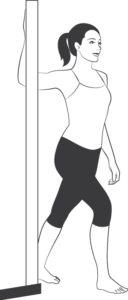Desk jockeys slouch and suffer, but once they learn the secrets of how to get rid of rounded shoulders, they’ll feel both taller and more aligned.
When you hear the term “bad posture,” two things immediately come to mind: forward head posture and rounded shoulders.
While I’ve previously covered 5 steps to fix forward head posture, in this article, I’ll walk you through 7 easy moves to get rid of rounded shoulders.
As you lean closer to your computer monitor and your shoulders begin to slouch, your body subconsciously adjusts. You reposition your head to keep your gaze straight, leading to muscular imbalances and shortening of the neck muscles. This, in turn, forces your upper back and shoulders into a rounded posture.

To reverse this hunched look and improve your upper body posture, there are TWO key things to focus on.
First, you need to stretch your chest muscles (pectorals), which are often tight and shortened from slouching forward.
Second, it’s crucial to strengthen your upper back muscles, particularly the posterior scapular stabilizers—muscles like the trapezius, rhomboids, and levator scapulae, which are responsible for pulling your shoulders back and maintaining proper alignment. By focusing on both stretching and strengthening, you’ll balance the muscles around your shoulders and restore a more upright posture.
Stretching Your Pectoral Muscles
Chest Stretch
To start, clasp your hands behind your back with your thumbs facing down. If you can’t clasp your hands, simply reach back as far as possible, aiming to open your chest.
With your hands in position, gently pull your shoulders back while keeping your spine tall and your chest lifted. As you stretch, take slow, deep breaths, feeling the tension release from your chest.
Hold this position for 20-30 seconds, focusing on maintaining a steady, controlled breath throughout.
Doorway Stretch

For the Doorway Stretch, stand in a doorway and raise your arms to shoulder height, forming a 90-degree angle with your elbows.
Place your palms on the doorjamb and slowly lean forward into the stretch, keeping your elbows in line with your shoulders. You should feel a deep stretch across your chest as you push against the doorframe, making sure not to arch your back or strain your neck.
Hold this position for 7-10 seconds, then release and relax your muscles, allowing them to recover. Be mindful of your breathing, taking slow inhales and exhales as you stretch to increase relaxation.
Repeat this stretch 2-3 times to fully loosen up tight pectoral muscles and improve your shoulder mobility, giving you better posture and upper body flexibility.
Strengthening Your Posterior Scapular Stabilizers
Bring out the resistance bands to strengthen the muscles that support good posture. A 2016 study in the Journal of Physical Therapy Science found that a seven-move resistance band program effectively lengthens the pectoral muscles and corrects rounded shoulders.
How To Get Rid of Rounded Shoulders in 7 Moves
Perform each of the following resistance band exercises for 15 repetitions, 3 sets total.
Move #1: Lat Pull Down
Explanation:
Let’s get started with the Lat Pull Down. You’ll need your resistance band anchored to a door at the top. Grab both ends of the band with your palms facing forward and arms shoulder-width apart.
- Stand tall with a slight bend in your knees and engage your core. Keep your chest lifted and maintain an upright posture.
- Slowly pull the band down towards your chest, bringing your elbows in close to your sides. Focus on squeezing your shoulder blades together as you pull the band down.
- Once the band reaches your chest, hold for a second and feel the contraction in your upper back muscles.
- Slowly release back to the starting position, keeping full control over the movement.
This exercise targets the lats and helps to pull your shoulders back into alignment. Remember, it’s all about control—focus on your form and not speed. Let’s go for 15 reps!
Move #2: Shoulder External Rotation
Explanation:
Next, we’re focusing on Shoulder External Rotations. Start with the band anchored at waist height. Stand tall, with your elbow bent at 90 degrees and tucked into your side—make sure it doesn’t flare out.
- Hold the band in one hand and slowly rotate your forearm out to the side, away from your body.
- Ensure that your elbow stays in place and doesn’t move forward or backward—only your forearm should be rotating.
- Once you reach your full range of motion, pause for a moment to feel the stretch, then slowly return to the starting position.
This exercise targets your rotator cuff, which stabilizes the shoulder joint and helps correct posture. Keep your movements controlled and smooth, feeling the burn in the back of your shoulder. Ready? Let’s go!
Move #3: Shoulder Horizontal Abduction
Explanation:
For the Shoulder Horizontal Abduction, hold the resistance band in front of you with both hands, arms extended straight out at shoulder height.
- Stand tall with your feet shoulder-width apart, keeping your core tight.
- Slowly pull the band apart, stretching it horizontally while keeping your elbows locked in place.
- Your arms should move outward to the sides, forming a T-shape as you pull the band.
- Pause when your arms are fully outstretched, squeezing your shoulder blades together, then slowly return to the starting position.
This move strengthens the upper back and rear deltoids, helping to correct rounded shoulders. Focus on squeezing your shoulder blades together for maximum benefit. Let’s get 15 solid reps!
Move #4: Seated Band Row
Explanation:
Now it’s time for the Seated Band Row. Sit with your legs extended in front of you, placing the middle of the band under your feet. Hold one end of the band in each hand.
- Sit up straight with your core engaged and knees slightly bent.
- Pull the band toward your waist, bringing your elbows back and squeezing your shoulder blades together as you row.
- Keep your elbows close to your body and your shoulders down—avoid shrugging them toward your ears.
- Slowly release the band back to the starting position, keeping tension on the band throughout the movement.
This exercise strengthens your mid-back muscles and improves shoulder alignment. Keep it slow and controlled—let’s go for 15 reps!
Move #5: Shoulder Abduction
Explanation:
For the Shoulder Abduction, step on the middle of the band with the foot on the side you’re working. Hold the end of the band in your hand by your side, with your palm facing your body.
- Slowly lift your arm out to the side, maintaining a slight bend in your elbow.
- Raise your arm until it reaches shoulder height, or as far as you can without discomfort.
- Once you reach the top, pause and feel the contraction in your shoulder, then slowly lower your arm back to the starting position.
This move targets the deltoid muscle, helping to lift and stabilize the shoulder. Focus on smooth, controlled movement—let’s aim for 15 reps with great form.
Move #6: Shoulder Flexion
Explanation:
Next up is the Shoulder Flexion exercise. Step on the band with the foot on the side you’re working and hold the band in that hand.
- Start with your arm straight down by your side, palm facing your body.
- Slowly lift your arm forward, keeping it straight, until it reaches shoulder height.
- Pause at the top, feeling the contraction, then slowly lower your arm back to the starting position.
This move strengthens the front of the shoulder, helping you maintain good posture. Keep the motion smooth and controlled, and avoid jerky movements. Ready for 15 reps? Let’s go!
Move #7: Shoulder Extension
Explanation:
For the Shoulder Extension, start with the band anchored in front of you. Hold one end of the band in your hand, keeping your arm straight and palm facing your body.
- Slowly pull the band straight back, extending your arm behind you.
- Keep your elbow straight and your shoulder down as you move your arm back.
- Once your arm is fully extended, pause and squeeze the muscles in the back of your shoulder, then slowly return to the starting position.
This exercise strengthens the muscles in the back of the shoulder and upper back, improving posture and stability. Focus on maintaining shoulder stability and control as you move. Let’s go for 15 reps with perfect form!
Final Thoughts
With each of these moves, the key is control and focus. Engage your muscles, especially your shoulders and upper back, during every repetition. These exercises are designed to help you improve your posture, so take your time and execute each one with precision. Perform these 7 moves 3-4 times per week, and you’ll start to see your rounded shoulders straighten and your posture improve!
Recommended Posture Book
Reverse Bad Posture Exercises offers 21 exercises to help fix forward head posture and rounded shoulders. In just 15 minutes a day, you can improve your posture and prevent future neck, shoulder, and back pain. Why am I recommending this posture book? Well, I wrote it, so you could say it’s straight from the horse’s perfectly aligned mouth.


